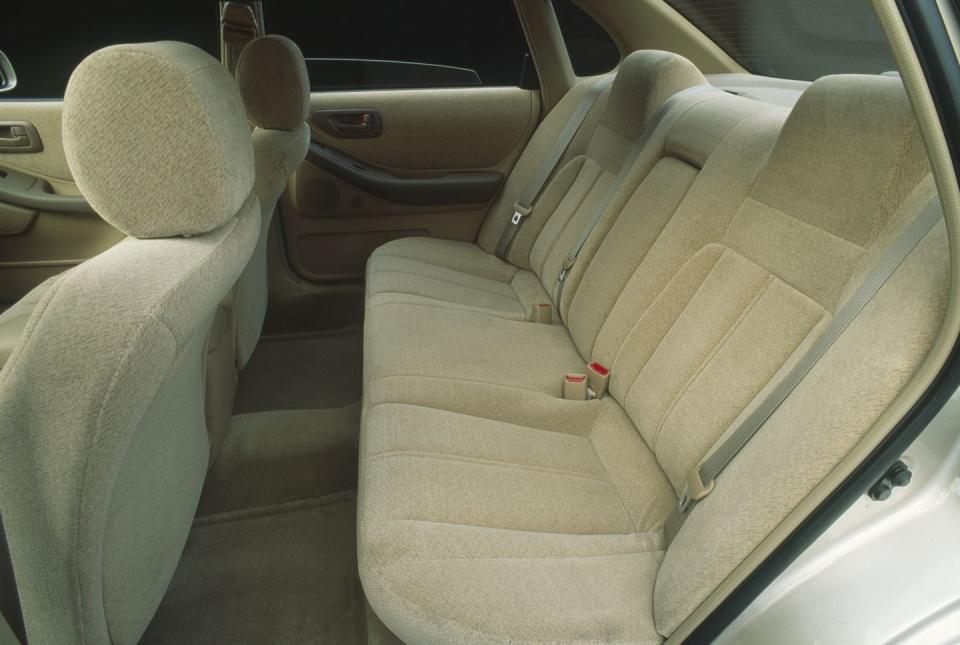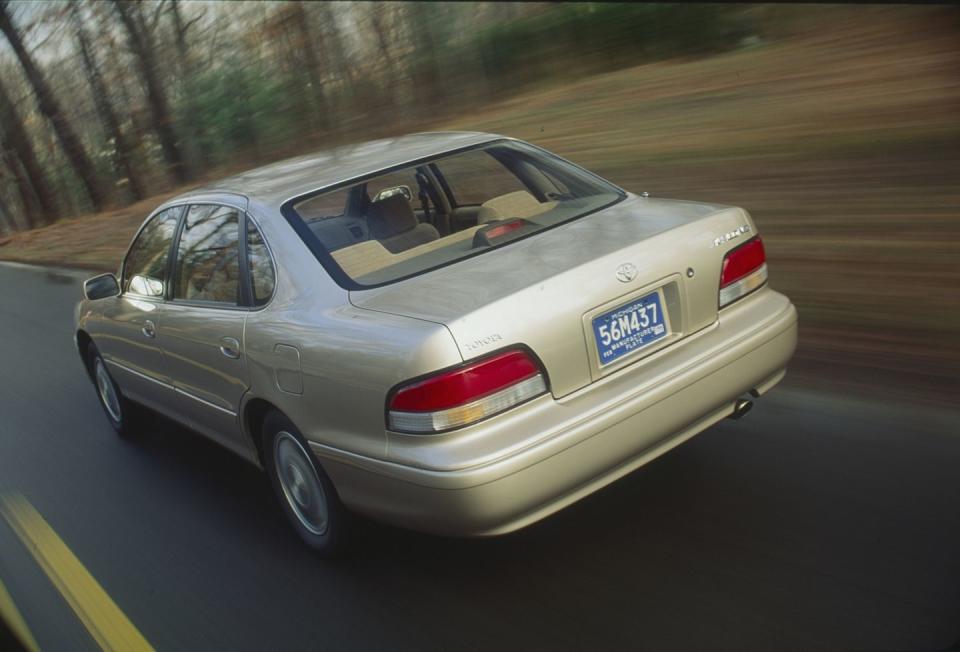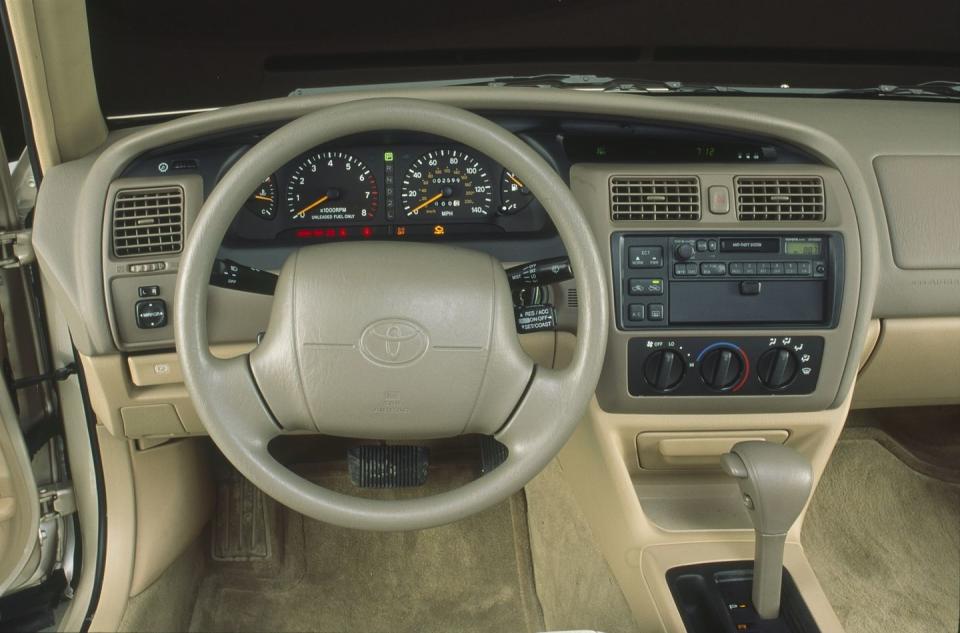Tested: 1995 Toyota Avalon XL, a Giant among Toyotas

From the April 1995 issue of Car and Driver.
Some fat-cat execs in Detroit may not want you to know about a ball-and-chain limiting the size of Japanese cars, lest you take pity and buy one of them.
But we'll tell you: an old Japanese tax law penalizing cars wider than 66.5 inches is responsible for the diminutive width of many Japanese assembly lines, and so the width and interior volume of cars from those lines are correspondingly wee. The only U.S. car approaching this narrowness is the Ford Escort. The roomy Nissan Maxima broke the 66.5-inch mold in 1988, principally because it was destined to be sold only in the U.S. The Acura Legend, the Lexus LS400, and the Infiniti Q45 all followed suit. Eventually, even the Toyota Camry went wide. But many other Japanese cars are still based on the old 66.5-inch tooling, even after a change in the tax law favored wider cars.
The Toyota Avalon now joins the select list of larger Japanese-brand cars. The Kentucky-built Avalon is based on a Camry platform that's been stretched 2.4 inches, and it contains other Camry front-drive parts.
Why a bigger Toyota? Toyota says baby-rearing baby boomers need something larger than a Camry or even a Lexus LS400 now that their broods are closer to the lanky teen years.
The Avalon looks and feels larger than a Camry. At 107.1 inches, the wheelbase is four inches longer. The rear track has been widened an inch to 60.0 inches (the 61-inch front track carries over from the Camry). The Avalon, however, is just half an inch wider than a Camry, at 70.3 inches.
The Avalon has the roomiest interior of any car of Japanese origin—bigger inside than a Lexus or an Infiniti. Yet at $23, 155, the Avalon costs only half as much as those big luxury cars. The Avalon's rear seat is larger than that of the $1100-less-expensive Nissan Maxima, a class leader in space. Tall guys can cross their legs like Warren Beatty while seated in the back of the Avalon. The only roomier cars are the Saab 9000, the long Chrysler LHs, the big Ford rear-drivers, and the GM full-size sedans. Several of the American-brand cars cost less than the Avalon, too. Of course, crossing your legs in the back of a car may be priority No. 29 on your shopper's checklist. But it gives you an idea of the room available.

The Avalon's rear seat is big enough to make you feel smaller, and there is space above rear passengers' heads even while they're getting in or out. Knee and foot space is generous; comfort and visibility back there are likewise notable. We were surprised just how much the rear quarter-windows aid visibility for rear passengers.
You can put a third passenger in the center of the rear seats, but the knees of anyone long-legged will hit the front seats.
The Avalon comes in two seating configurations—five-passenger or six-passenger—and two trim levels. Our five-seat (front-bucket-equipped) XL test car weighed 3271 pounds. Toyota says that's just 22 pounds more than a similarly equipped Camry LE V-6. A six-seat (front-bench-equipped) Avalon adds another 22 pounds. These weight differences are not enough to noticeably affect performance.

The Camry's 3.0-liter V-6 powers the Avalon, but it has retuned manifolds that bump horsepower from 188 to 192 and torque from 203 to 210 pound-feet.
Our Avalon accelerated better than the last Camry XLE we tested because the bigger car has shorter final-drive gearing. Surprisingly, the Avalon's EPA fuel economy ratings are better than the Camry's. Toyota says that's because the Avalon is slicker to the wind, even though it sits an inch taller and 0.6 inch wider than a Camry. The Avalon is rated at 20 mpg on the EPA city cycle, while the Camry V-6 returns 18 mpg. We observed 18 mpg in all conditions with the Avalon.
The Avalon uses the same electronically controlled four-speed automatic transmission as the Camry, with "normal" and "power" modes, but this feature is not essential for squeezing maximum performance from the engine: full-throttle shifts occur in both modes at the 6250-rpm redline. In fourth gear, the engine loafs along at a perfectly relaxed 3000 rpm at 85 mph.
Acceleration is smooth and controlled, with little torque-steer even when the front wheels are turned. But traction feels noticeably inferior to a Camry's. The weight distribution of the Avalon is identical to that of a similarly equipped Camry, so we'll say the tire compounds on our test car, plus the Avalon's shorter final-drive gearing, caused the extra wheelspin.
The same problem exists here that we encountered with the V-6–powered Honda Accord: making a great sedan bigger or heavier doesn't guarantee it will retain all of its great qualities. The Avalon feels more softly sprung than a Camry, and therefore heavier, even though it's not. In corners, the Avalon generates 0.81 g, which is slightly better than the grip a Camry offers.

Some elements inside the Avalon lead you to believe it was "parts-shelf" engineered (meaning put together from existing pieces and therefore less expensive to develop). The Lexus-like center console, which is standard on five-seat Avalon models, and the cupholder would be patent infringements if found on any other brand; likewise with the cruise-control switch.
We did notice some un-Lexus-like vibrations in the instrument panel on our test car, but only when we drove on washboard surfaces and over small bumps.
The trunk is usefully big, with nice carpet lining that discourages messy loads. Liftover is moderately high, and the taillights block some of the trunk access. Also, there's no cargo net, suggesting that even the Avalon's healthy level of roadholding won't be fully exploited by the driver. The Avalon family obviously doesn't ski, since there's no pass-through from the trunk to the back seat.
When Lexus, Toyota's luxury division, was created in 1988, Toyota said one goal was to lure back committed buyers of smaller Toyotas. These folks had been graduating to European cars and Acuras when they got older and richer. May we suggest that some Toyota fans must have moved into Buicks, too, because the soft-riding Avalon seems to share ride traits with that GM division's cars. Translation: the Avalon is not a sporty, exciting sedan, but it's a great big car. This is the car you recommend to a neighbor who doesn't much like driving. He'll never complain about the Avalon, and he won't be a moving roadblock on the highway, either.
Counterpoints
"Choosing between that Avalon and a Camry is like choosing between Detroit and Cleveland," Berg told me before I took it home. Well, he's half right. In SE trim, the Camry does have a hint of rock 'n' roll about it. The Avalon doesn't have a drop of soul though, not a heart-fluttering line or movement. The lone indication of any possible fun is on the Caprice-like dash. Push the "ECT POWER" switch and the objects outside your window go by slightly faster. It's another well-executed Toyota—but if the Camry could be desexed, this would be the result. —Martin Padgett Jr.
Okay, so it isn't a breathtaking face, but neither is Meryl Streep's, and she manages to exude a fair whack of refinement and sophistication. Ditto the Avalon, the Cressida for the coming millennium. This is the Caprice that GM wishes it had built. I remember driving a Lexus ES300 to the Dearborn Hyatt, where the parking valet said to me: "Hey, man, you know this Lexus you're driving is actually a disguised Toyota?" I want to roll up in the Avalon and tell him, "Hey man, you know this Toyota I'm driving is actually a disguised Lexus?" —John Phillips
Hmmm. Toyota launches a full-size vehicle into a domestic-dominated market; it offers higher build quality than its yankee rivals but at a substantial price premium; and the biggest engine you can get is a V-6. It's like T100 pickup déjà vu all over again. Avalon sales may follow the T100's lead, too. Its high price and arch-conservative styling pit it against big, old people's sedans, like the Buick Roadmaster, but inside there's less hip and shoulder room than in a Chevy Lumina. To me that spells identity crisis—and sales trouble. —Frank Markus
You Might Also Like

 Yahoo Autos
Yahoo Autos 